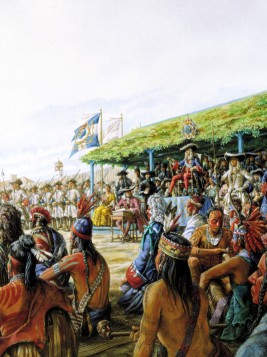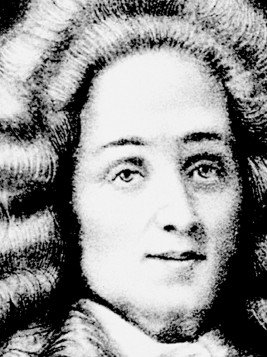Major events
The Great Peace of Montréal
In summer 1701, Montréal was the scene of a major historical event: the signature of the Great Peace treaty. This treaty put an end to several decades of conflict between the Iroquois, allies of the English, and the French and their allied Indigenous People. As such, it marks the turning point in Franco-Amerindian relations featuring Louis Hector de Callière and Kondiaronk, the Huron-Wendat Grand Chief.
In 1690 negotiations betweeen the French and the Indigenous People were initiated, in order to put an end to a hundred years of conflict centered around the fur trade. These negotiations undertaken by Frontenac, Governor of New France, culminated under the governorship of his successor, Louis-Hector de Callière. After several years of negotiations marked by numerous setbacks and reversals, more than 1300 delegates from 39 different First Nations in the north-east of America finally came together at Montréal, in August 1701, to agree to a general peace treaty between themselves and the French.
Over the course of a week, delicate negotiations and long discussions take place, but it is the intervention of the Huron-Wendat Grand Chief, Kondiaronk, that provides the turning point. As a result of his convincing speech, the most resistant factions are convinced to conclude an agreement. Exhausted and weakened by illness, Kondiaronk dies the next day and his funeral is organized in Montréal.
On August 4, 1701, the deliberations come to an end, and the delegates of the First Nations place their totemic marks beside Louis-Hector de Callière's name, who signs on behalf of the King of France.
An enduring agreement
With the Great Peace of Montréal, the Native People renounce war and they also defer to the French to settle disagreements as well as accepting to share their hunting territories. The Iroquois agree to free their captives, to stay neutral in conflicts between France and England and to no longer oppose the founding of Detroit, at the heart of the Great Lakes. In return, the Iroquois, weakened by the extremely long conflict, obtain the right to trade freely. Governor de Callière, for his part, promises the provide merchandise at lower cost to the Native People.
Finally, the Great Peace slows the continental expansion of the British colonies and facilitates New France’s. As de Callière had hoped, the agreement holds despite a conflict or two over the following years and consolidates the broad network of alliances between the French and the Amerindians, a network that is maintained right up until the conquest of New France by the British in 1760.
Pointe-à-Callière commemorates the event
This major event was forgotten over the centuries, absent from our history books and in our collective memory. It is only in the nineties that research and other initiatives revived memory of this chapter in our history. In 1997, the belvedere atop Mount Royal is renamed after Kondiaronk. The presence of our Native People is also at the heart of the permanent exhibit at Pointe-à-Callière. Founded in 1992, it was the first museum in Québec to commemorate the Great Peace of Montréal, by displaying engraved Amerindian pictograms extracted from the 1701 treaty on one of the four copper plaques on the side of Place Royale.
The 300th anniversary of the event is also marked in 2001 by a series of events including an exhibition at Pointe-à-Callière – 1701 - The Great Peace of Montréal – where the manuscript of the Great Peace treaty is displayed. In addition, the City of Montréal renames a portion of Place d’Youville, Place de la Grande-Paix-de-Montréal, where the obelisk honours the founders of Ville-Marie, but which also indicates the location where the treaty was signed.
Finally, in 2014 Pointe-à-Callière acquires artist Nicolas Sollogoub’s work entitled 1701. The Great Peace of Montréal. This magnificent glasswork is now integrated into the Where Montréal Was Born exhibition and can be appreciated by all visitors. Made up of 16 panels 6 metres long by 1.5 metres high (20 feet by 5 feet) the work illustrates where the treaty was signed as well as the principal players that took part in the event. The glasswork is made of painted plexiglass, engraved and varnished with acrylic applied to two sheets of glass.


